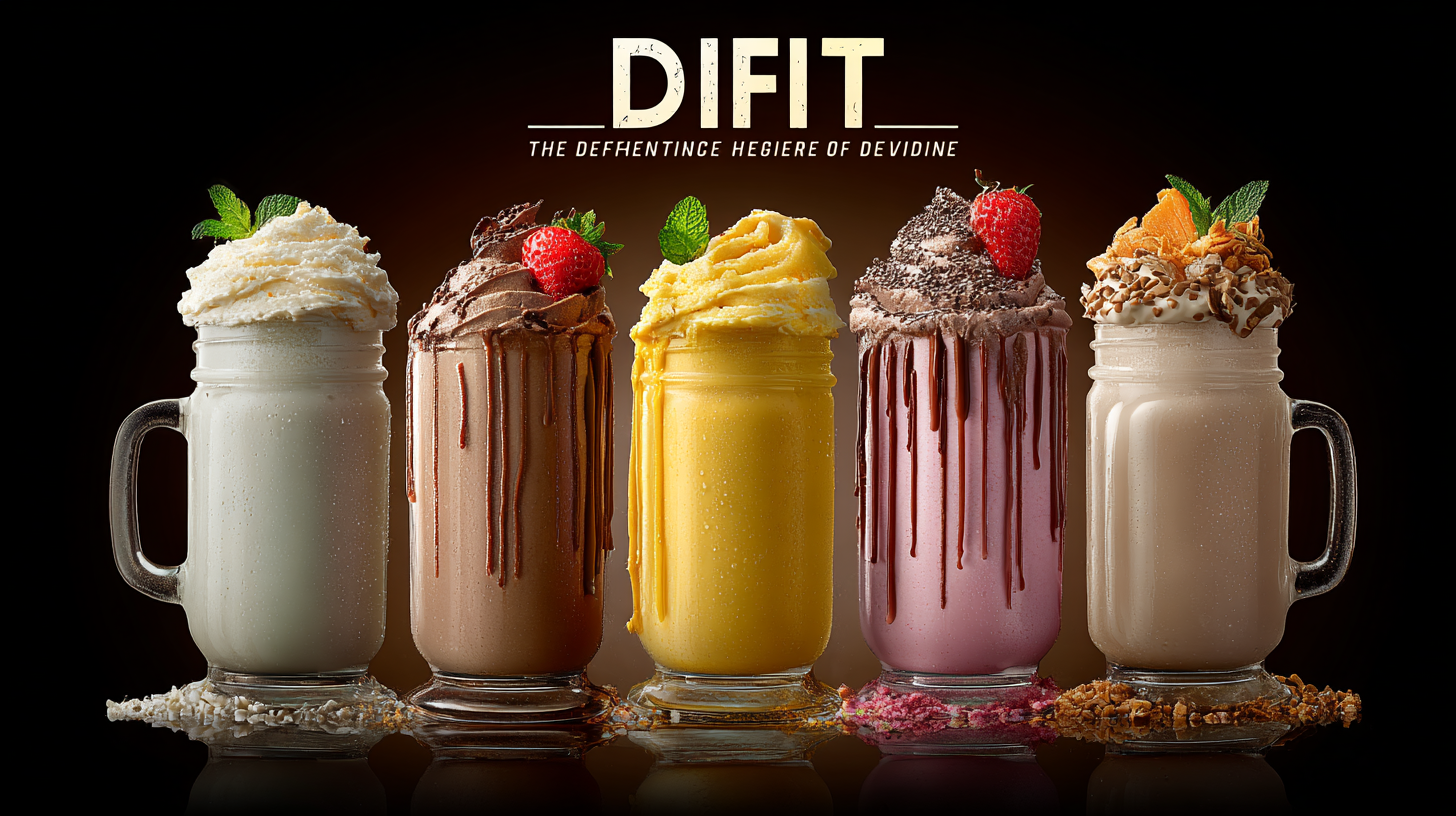Exclusive Offer: Limited Time - Inquire Now!
For inquiries about our products or pricelist, please leave your email to us and we will be in touch within 24 hours.
For inquiries about our products or pricelist, please leave your email to us and we will be in touch within 24 hours.
As the demand for health and wellness products continues to surge globally, the diet replacement shakes market has emerged as a pivotal element in the nutritional landscape. According to a recent market research report by Grand View Research, the global meal replacement market is projected to reach $8.2 billion by 2025, with diet replacement shakes accounting for a significant portion of this growth. As consumers become increasingly health-conscious, the importance of choosing the right diet replacement shakes cannot be overstated. These products offer convenience as well as targeted nutrition, catering to diverse dietary needs ranging from weight loss to muscle gain. In this definitive guide, we will explore the latest trends in the industry, provide insights into the various types of diet replacement shakes available, and equip you with the knowledge needed to make informed purchasing decisions in 2025 and beyond.

As we look towards 2025, the diet replacement shake industry is poised for significant transformation. One of the key trends is the shift towards plant-based ingredients. Consumers are increasingly seeking shakes that are not only healthy but also environmentally sustainable. This trend reflects a growing awareness of the impact of food choices on personal health and the planet. Brands that emphasize organic, non-GMO, and locally sourced components are expected to thrive in this competitive marketplace.
Tip: When selecting a diet replacement shake, pay attention to the ingredient list. Look for shakes that contain whole food ingredients and avoid those with excessive sugars and artificial additives.
Another notable trend is the personalization of diet shakes. With the rise of technology and data analysis, consumers can now tailor their shakes to meet specific nutritional needs and preferences. This customization may include adjusting macronutrient ratios or incorporating supplements for specific health goals, such as weight loss or muscle gain.
Tip: Consider your individual health goals and dietary restrictions, as personalized shakes can better support your journey towards optimal wellness. Explore brands that offer customizable options to maximize the benefits of your diet replacement shake.
| Feature | Trend | 2025 Projection | Growth Rate (%) | Target Audience |
|---|---|---|---|---|
| Plant-Based Ingredients | Rising Demand | 65% of total market | 15% | Vegan consumers |
| High Protein Content | Health Focused | 70% of new launches | 12% | Fitness enthusiasts |
| Low Sugar Options | Consumer Preference | 55% of market | 10% | Health-conscious individuals |
| Convenience Packaging | On-The-Go Trends | 60% preference | 8% | Busy professionals |
| Personalization | Tailored Nutrition | 40% increase | 20% | Health-tracking individuals |
When selecting diet replacement shakes, several essential factors must be taken into account to ensure you make the best choice for your nutritional needs. Firstly, the ingredient list is paramount. Look for shakes that offer high-quality protein sources, such as whey or plant-based proteins, as these contribute to muscle maintenance and satiety. Additionally, avoid shakes with artificial sweeteners, preservatives, or excessive sugar, as these can undermine your health goals. A blend of vitamins and minerals is also crucial to ensure you’re not missing out on vital nutrients during your diet.
Another important aspect to consider is the caloric content of the shakes. Depending on your weight loss target, select shakes that fit into your overall calorie plan, typically around 200-400 calories per serving. It’s helpful to choose shakes that are lower in calories but high in fiber, prompting longer-lasting fullness and decreasing the likelihood of unhealthy snacking. Lastly, personal taste and texture should not be overlooked. Finding a shake that you enjoy will help you stick to your diet plan and achieve your weight management goals more effectively.
When selecting the best diet replacement shakes, a comparative analysis of the nutritional composition and ingredient integrity is essential. The rising popularity of these shakes among health-conscious consumers demands a careful examination of brands to ensure they meet the necessary nutritional standards. Recent studies on high-protein foods highlight the importance of verifying the actual protein, fat, carbohydrates, and energy content against labeling data. This scrutiny is vital as misleading labels can affect consumer choices and health outcomes.
In addition to protein sources, the digestibility and metabolic effects of various shake ingredients play a crucial role in their effectiveness. For instance, comparisons between plant-based and whey protein derivatives may reveal significant differences in how well the body utilizes these proteins for muscle recovery and growth. Furthermore, understanding the profiles of different milk powders, such as cow, goat, and sheep milk, provides insights into the inherent nutritional advantages each can offer. By focusing on these critical aspects, global buyers can make informed choices that suit their dietary needs and preferences, ensuring they select the most beneficial meal replacement shakes available.

When selecting diet replacement shakes, understanding their nutritional content is paramount. A comprehensive analysis by the Nutritional Journal highlights that a well-formulated diet shake should ideally contain a balanced ratio of macronutrients: approximately 25% protein, 45% carbohydrates, and 30% fats. This proportion not only supports weight management but also ensures that the body receives essential nutrients to maintain energy and overall health.
Moreover, it is crucial to evaluate the fiber content in these shakes, as dietary fiber plays a vital role in promoting satiety and digestive health. According to a report from the International Journal of Obesity, shakes enriched with at least 5 grams of fiber can help individuals feel fuller for longer, aiding in calorie control. Additionally, buyers should be wary of added sugars; the American Heart Association recommends limiting added sugars to no more than 10% of daily calories. Therefore, selecting diet replacement shakes with minimal added sugars can enhance health outcomes while still supporting dietary goals.
This chart displays the average nutritional content of various diet replacement shakes based on protein, carbohydrates, and fats per serving. The values are estimated for a standard serving of each shake.
The global market for diet replacement shakes is significantly influenced by regional preferences, particularly in the Middle East and Africa (MENA). Analyzing the MENA retail market size reveals diverse customer preferences based on cultural influences and dietary needs. In 2025, the MENA retail market is projected to reach substantial figures, with diet-related products gaining traction. Consumers in this region lean towards alternatives that cater to local taste profiles, which are often intertwined with health and wellness trends. This regional variance underscores the importance of tailored marketing strategies that resonate with local consumers.
In comparison to other sectors, the growth within the diet replacement segment aligns with broader trends evident in various markets, such as cosmetics and personal care. The global cosmetics OEM and ODM market is anticipated to grow from USD 33.32 billion in 2024 to approximately USD 55.12 billion by 2033. This growth trajectory hints at the rising inclination towards customized solutions that satisfy consumer preferences. Similarly, the wedding photography market—which is also witnessing significant changes—emphasizes the demand for specific services that reflect regional aesthetics, paralleling the customization trend noted in dietary products. The intersection of cultural preferences and product choices highlights a growing need for brands to adapt to local markets in their offerings.

